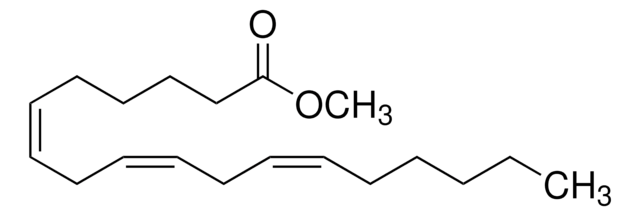L2626
Methyl linolenate
≥99% (GC)
Synonym(s):
Linolenic acid methyl ester, Methyl cis,cis,cis-9,12,15-octadecatrienoate
About This Item
Recommended Products
biological source
plant
Quality Level
Assay
≥99% (GC)
form
liquid
refractive index
n20/D 1.470 (lit.)
bp
182 °C/3 mmHg (lit.)
density
0.895 g/mL at 25 °C (lit.)
functional group
ester
lipid type
unsaturated FAs
shipped in
ambient
storage temp.
−20°C
SMILES string
CC\C=C/C\C=C/C\C=C/CCCCCCCC(=O)OC
InChI
1S/C19H32O2/c1-3-4-5-6-7-8-9-10-11-12-13-14-15-16-17-18-19(20)21-2/h4-5,7-8,10-11H,3,6,9,12-18H2,1-2H3/b5-4-,8-7-,11-10-
InChI key
DVWSXZIHSUZZKJ-YSTUJMKBSA-N
Looking for similar products? Visit Product Comparison Guide
Application
- Exogenous Jasmonic Acid Alleviates Blast Resistance Reduction Caused by LOX3 Knockout in Rice.: The research explores the role of jasmonic acid, associated with methyl linolenate, in enhancing blast resistance in rice. The findings show that external application of jasmonic acid can compensate for the resistance loss due to LOX3 knockout, providing insights into plant disease management strategies (Su et al., 2023).
- Effects of (13)C isotope-labeled allelochemicals on the growth of the invasive plant Alternanthera philoxeroides.: This study uses (13)C-labeled methyl linolenate to trace allelochemical effects on invasive plant species. The results indicate a significant impact on plant growth, suggesting potential applications in controlling invasive species (Hua et al., 2023).
Biochem/physiol Actions
Storage Class Code
10 - Combustible liquids
WGK
WGK 1
Flash Point(F)
235.4 °F - closed cup
Flash Point(C)
113.0 °C - closed cup
Personal Protective Equipment
Choose from one of the most recent versions:
Already Own This Product?
Find documentation for the products that you have recently purchased in the Document Library.
Customers Also Viewed
Our team of scientists has experience in all areas of research including Life Science, Material Science, Chemical Synthesis, Chromatography, Analytical and many others.
Contact Technical Service











